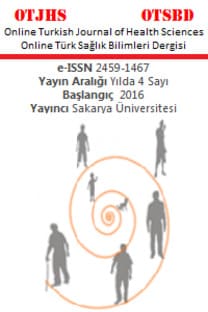COVID-19 Şüphesi Olan Çocuklarda Gastrointestinal Sistem Tutulumu: Türkiye’ den Tek Merkez Deneyimi
COVID-19, çocuk, gastrointestinal semptom
Gastrointestinal System Involvement in Children suspected for COVID-19: A Single Tertiary Center Experience from Turkey
children, COVID-19, gastrointestinal symptom,
___
- Li LQ, Huang T, Wang YQ, et al. COVID-19 patients' clinical characteristics, discharge rate, and fatality rate of meta-analysis. J Med Virol. 2020;92(6):577-583. doi: 10.1002/jmv.25757
- Lee IC, Huo TI, Huang YH. Gastrointestinal and liver manifestations in patients with COVID-19. J Chin Med Assoc. 2020:83(6): 521-523. doi: 10.1097/JCMA.0000000000000319
- Huang C, Wang Y, Li X, et al. Clinical features of patients infected with 2019 novel coronavirus in Wuhan, China. Lancet. 2020;395:497-506.
- Mao R , Qiu Y, He JS, et al. Manifestations and Prognosis of gastrointestinal and liver involvement in patients with COVID-19: A systematic review and meta-analysis. Lancet Gastroenterol Hepatol. 2020;5(7):667-678. doi: 10.1016/S2468-1253(20)30126-6
- Inciardi RM, Lupi L, Zaccone G, et al. Cardiac involvement in a patient with coronavirus disease 2019 (COVID-19). JAMA Cardiol. 2020 doi: 10.1001/jamacardio.2020.1096
- Xu XW, Wu XX, Jiang XG, et al. Clinical findings in a group of patients infected with the 2019 novel coronavirus (SARS-CoV2) outside of Wuhan, China: retrospective case series. BMJ. 2020;368:m606. doi: 10.1136/bmj.m606
- Ye M, Ren Y, Lv T. Encephalitis as a clinical manifestation of COVID-19. Brain Behav Immun. 2020;S0889-1591(20)30465-7. doi: 10.1016/j.bbi.2020.04. 017
- Wu P, Duan F, Luo C, et al. Characteristics of ocular findings of patients with coronavirus disease 2019 (COVID-19) in Hubei Province, China. JAMA Ophthalmol. 2020;138:575–8. doi: 10.1001/jamaophthalmol.2020. 1291
- Recalcati S. Cutaneous manifestations in COVID-19: a first perspective. J Eur Acad Dermatol Venereol. 2020 34(5):212-213. doi: 10.1111/jdv. 16387
- Rotzinger DC, Beigelman-Aubry C, von Garnier C, Qanadli SD. Pulmonary embolism in patients with COVID-19: time to change the paradigm of computed tomography. Thromb Res. 2020;190:58–59. doi: 10.1016/j.thromres.2020.04.011
- Zhang C, Shi L, Wang FS. Liver injury in COVID-19: management and challenges. Lancet Gastroenterol Hepatol. 2020;5:428-30. doi: 10.1016/ S2468-1253(20)30057-1
- Yuki K, Fujiogi M, Koutsogiannaki S. COVID-19 pathophysiology: A review. Clin Immunol. 2020;215:108427. doi: 10.1016/j.clim.2020.108427
- Lai CC, Ko WC, Lee PI, Jean SS, Hsueh PR. Extra-respiratory manifestations of COVID-19. Int J Antimicrob Agents. 2020:106024. doi: 10.1016/j.ijantimicag.2020.106024
- Wang D, Ju X, Xie F, et al. Clinical analysis of 31 cases of 2019 novel coronavirus infection in children from six provinces (autonomous region) of northern China. Zhonghua Er Ke Za Zhi. 2020;58(4):269-274. doi: 10.3760/cma.j.cn112140-20200225-00138
- Zachariah P, Johnson CL, Halabi KC, et al. Epidemiology, clinical features, and disease severity in patients with coronavirus Disease 2019 (COVID-19) in a children's hospital in New York City, New York. Columbia Pediatric COVID-19 Management Group. JAMA Pediatr. 2020;e202430. doi: 10.1001/jamapediatrics.2020.2430
- Garazzino S, Montagnani C, Donà D, et al. Multicentre Italian study of SARS-CoV-2 infection in children and adolescents, preliminary data as at 10 April 2020. The Italian SitipSip Pediatric Infection Study Group. Euro Surveill. 2020;25(18):2000600. doi: 10.2807/1560-7917.ES.2020.25.18.2000600
- Nicoletti A, Talarico V, Sabetta L, et al. Screening of COVID-19 in children admitted to the hospital for acute problems: preliminary data. Acta Biomed. 2020;91(2):75-79. doi: 10.23750/abm.v91i2.9607
- Xia W, Shao J, Guo Y, et al. Clinical and CT features in pediatric patients with COVID-19 infection: different points from adults. Pediatr Pulmonol. 2020;55(5):1169-1174. doi: 10.1002/ppul.24718
- Tian Y, Rong L , Nian W , He Y. Review Article: Gastrointestinal features in COVID-19 and the possibility of faecal transmission. Alient Pharmacol Ther. 2020;51(9):843-851. doi: 10.1111/apt.15731
- Ng SC, Tilg H. COVID-19 and the gastrointestinal tract: more than meets the eye. Gut. 2020;69(6):973-974. doi: 10.1136/gutjnl-2020-321195
- Ping A, Hongbin C, Xiaoda J, Honggang Y. Clinical features of 2019 novel coronavirus pneumonia presented gastrointestinal symptoms but without fever onset. Lancet. 2020. https:// ssrn.com/abstract=3532530. Accessed March 15, 20020.
- Dong Y, Mo X, Hu Y, et al. Epidemiology of COVID-19 among children in China. Pediatrics. 2020;145(6): e20200702. doi: 10.1542/peds.2020-0702
- Qiu H, Wu J, Hong L, Luo Y, Song Q, Chen D. Clinical and epidemiological features of 36 children with coronavirus disease 2019 (COVID-19) in Zhejiang, China: an observational cohort study. Lancet Infect Dis. 2020;S1473-3099(20)30198-5. doi: 10.1016/S1473-3099(20)30198-5
- Drescher B, Bai F. Neutrophil in viral infections, friend or foe?. Virus Res. 2013;171(1):1-7. doi: 10.1016/j.virusres.2012.11.002
- ISSN: 2459-1467
- Yayın Aralığı: Yılda 4 Sayı
- Başlangıç: 2016
- Yayıncı: Oğuz KARABAY
Ayşe Ferdane OGUZONCUL, Osman KURT, S. DEVECİ
Kandidemi Oolgularında Candida türlerinin Dağılımı ve Sağ kalıma Etki Eden Faktörlerin Belirlenmesi
Aziz Ahmad HAMİDİ, Cüneyt KURU
Diyaliz Tedavisi Gören Anne ve Bebeğinin Hemşirelik Yönetimi: Bir Olgu Sunumu
Öznur TİRYAK, Nursan ÇINAR, İbrahim CANER
Gebelikte Sigara Kullanımının Prenatal Bağlanmaya Etkisi
Filiz ÖZÇOBAN, Hacer YALNIZ DİLCEN, Serap KAYNAK, Nesibe UZEL
İlknur Esen YILDIZ, Ayten YILMAZ YAVUZ
Sağlık Araştırmalarında Matematik Model Kullanımı
Gebelerde Sağlıklı Yaşam Davranışlarının ve Etkileyen Faktörlerin Belirlenmesi
HANDAN ÖZCAN, Tuğçe POLAT, Mücahid YILMAZ, Arif ÖZTÜRK, Tolga AYDOĞAN
Canan BİRİMOĞLU OKUYAN, Süreyya NUR, Fatma KARASU, Ebru DEVECİ
Bariatrik Cerrahinin Beslenme Okuryazarlığı Üzerine Etkisi: Bir Vaka-Kontrol Çalışması
